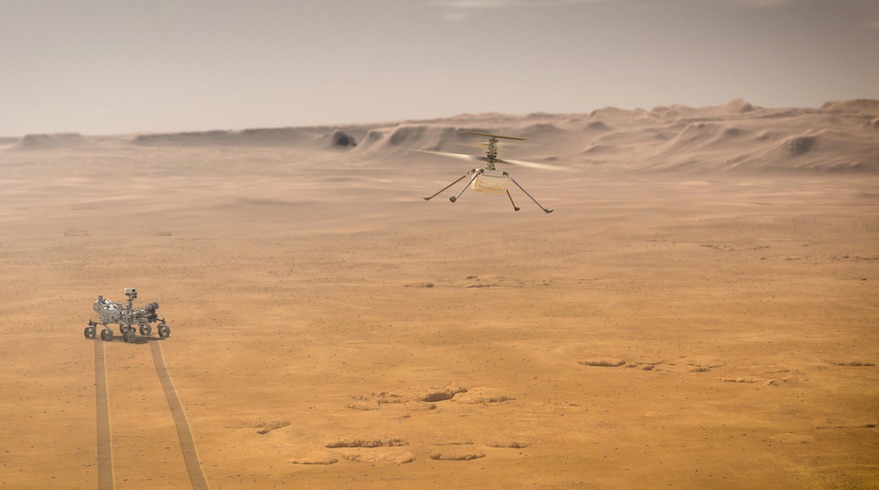WASHINGTON — A small helicopter that hitched a ride on NASA’s Perseverance rover will attempt its first flight on Mars in early April, demonstrating technology that could be used on future missions.
At a March 23 briefing, NASA officials discussed plans to perform the first flights of Ingenuity, a 1.8-kilogram helicopter currently attached to the underside of Perseverance. On March 21, spacecraft controllers started the process of deploying Ingenuity by jettisoning a cover that protected the vehicle during flight.
Perseverance is in the process of driving to an “airfield,” a flat area 10 by 10 meters. Over the course of 10 days, the spacecraft will perform a series of deployments to unfold Ingenuity and drop it on the surface. “That’s a very prescribed and meticulous process,” said Farah Alibay, Perseverance integration lead for Ingenuity at the Jet Propulsion Laboratory, involving separating a sequence of attachments, all documented using cameras on the rover.
The rover will drive away and, once Ingenuity’s solar panel charges up its battery, it will be ready for its first flight. “The first flight is special. It’s by far the most important flight that we plan to do,” said Håvard Grip, Ingenuity chief pilot. “It will be the first powered flight by an aircraft on another planet.”
On that flight, tentatively scheduled for April 8, Ingenuity will take off and climb to an altitude of three meters. It will then hover in place for 30 seconds while turning, then land. Project officials call that flight a “Wright Brothers’ moment” and, to demonstrate that connection, included a swatch of fabric, the size of a postage stamp, from the original Wright Brothers’ Flyer on Ingenuity.
If that first flight is successful, the project will attempt up to four more over the next month of increasing duration. Ingenuity can fly for up to 90 seconds at a time, with plans to go to altitudes of about five meters and travel as much as 50 meters downrange and back.
Ingenuity was extensively tested on the ground, including flight tests in vacuum chambers to simulate Martian atmospheric conditions, but project officials said those demonstrations could not test everything. “The biggest challenge will be that we are flying in the atmosphere of Mars, which has its own dynamics, its own winds, wind gusts and so forth,” said J. (Bob) Balaram, Ingenuity chief engineer. “There’s nothing that beats actually being in the real environment of Mars.”
The $85 million Ingenuity is solely a technology demonstration. Even if the helicopter performs its series of flights flawlessly, there are no plans to extend the mission beyond the 31 days allocated for flights. That’s because NASA wants Perseverance, which will observe the flights from a safe distance, to move ahead with its primary science mission.
“It’s the month of Ingenuity,” said Bobby Braun, director for planetary science at JPL. “We also have a science mission to conduct, a very important science mission that’s going to gather the samples that will eventually come back to Earth as part of the Mars Sample Return campaign. So, that month is our window to conduct the technology demonstration experiment, and we’re confident that we can do so.”
There are no firm plans to send helicopters like Ingenuity to Mars on future missions, but Braun argued that a successful demonstration might be analogous to Sojourner, the small rover that was part of the Mars Pathfinder lander mission in 1997. “Sojourner demonstrated the value of surface mobility,” he said. “In the same spirit, I can only imagine where we may be a decade or so from now.”
NASA is already pursuing another mission that will fly through the atmosphere of another world. Dragonfly will go to Saturn’s largest moon, Titan, and fly like a drone in its dense atmosphere to hop from one location to another. Balaram said the project has been in discussions with the Dragonfly on topics like development of a test program.
“It’s going to be really interesting to see how this kind of capability will scale up,” said Lori Glaze, director of NASA’s planetary science division. “What we learn from this experiment will definitely feed forward.”
